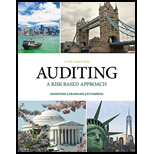
Auditing: A Risk Based-Approach (MindTap Course List)
11th Edition
ISBN: 9781337619455
Author: Karla M Johnstone, Audrey A. Gramling, Larry E. Rittenberg
Publisher: Cengage Learning
expand_more
expand_more
format_list_bulleted
Question
Chapter 5, Problem 29RQSC
To determine
Introduction: Auditing means the inspection of financial accounts of the company to determine if the records are accurate as per the rules and regulations of accounting or not. There are two types of auditors i.e. internal auditors and external auditors, that carry out the
To state: The alternative courses of action for financial statements when deficiencies are identified and when they are not identified.
Expert Solution & Answer
Want to see the full answer?
Check out a sample textbook solution
Students have asked these similar questions
What is the current book value of the equipment?
Please help me solve this general accounting problem with the correct financial process.
Please provide the accurate answer to this financial accounting problem using valid techniques.
Chapter 5 Solutions
Auditing: A Risk Based-Approach (MindTap Course List)
Ch. 5 - Prob. 1CYBKCh. 5 - Prob. 2CYBKCh. 5 - Prob. 3CYBKCh. 5 - Prob. 4CYBKCh. 5 - Prob. 5CYBKCh. 5 - Prob. 6CYBKCh. 5 - Prob. 7CYBKCh. 5 - Prob. 8CYBKCh. 5 - Prob. 9CYBKCh. 5 - Prob. 10CYBK
Ch. 5 - Prob. 11CYBKCh. 5 - Prob. 12CYBKCh. 5 - Prob. 13CYBKCh. 5 - Prob. 14CYBKCh. 5 - Prob. 15CYBKCh. 5 - Which of the following accounts would not be...Ch. 5 - Prob. 17CYBKCh. 5 - Prob. 18CYBKCh. 5 - Prob. 19CYBKCh. 5 - Which management assertion is usually most...Ch. 5 - Prob. 21CYBKCh. 5 - Prob. 22CYBKCh. 5 - Prob. 23CYBKCh. 5 - Prob. 24CYBKCh. 5 - Prob. 25CYBKCh. 5 - Prob. 26CYBKCh. 5 - Prob. 27CYBKCh. 5 - Prob. 28CYBKCh. 5 - Prob. 29CYBKCh. 5 - Prob. 30CYBKCh. 5 - Prob. 31CYBKCh. 5 - Prob. 32CYBKCh. 5 - Prob. 33CYBKCh. 5 - Prob. 34CYBKCh. 5 - Prob. 35CYBKCh. 5 - Prob. 36CYBKCh. 5 - Prob. 37CYBKCh. 5 - Prob. 38CYBKCh. 5 - Prob. 39CYBKCh. 5 - Prob. 40CYBKCh. 5 - Prob. 41CYBKCh. 5 - Prob. 42CYBKCh. 5 - Prob. 43CYBKCh. 5 - Prob. 44CYBKCh. 5 - Prob. 45CYBKCh. 5 - Prob. 46CYBKCh. 5 - Prob. 47CYBKCh. 5 - Prob. 48CYBKCh. 5 - Prob. 1RQSCCh. 5 - Prob. 2RQSCCh. 5 - Prob. 3RQSCCh. 5 - Prob. 4RQSCCh. 5 - Prob. 5RQSCCh. 5 - Prob. 6RQSCCh. 5 - Professional guidance indicates that the auditor...Ch. 5 - Identify the accounts associated with the...Ch. 5 - Assume that an organization asserts that it has...Ch. 5 - Prob. 10RQSCCh. 5 - Prob. 11RQSCCh. 5 - Prob. 12RQSCCh. 5 - Prob. 13RQSCCh. 5 - List factors that might affect an audit firm’s...Ch. 5 - Prob. 15RQSCCh. 5 - Prob. 16RQSCCh. 5 - Prob. 17RQSCCh. 5 - Prob. 18RQSCCh. 5 - Prob. 19RQSCCh. 5 - Prob. 20RQSCCh. 5 - Prob. 21RQSCCh. 5 - Prob. 22RQSCCh. 5 - Prob. 23RQSCCh. 5 - Prob. 24RQSCCh. 5 - Prob. 25RQSCCh. 5 - Prob. 26RQSCCh. 5 - Prob. 27RQSCCh. 5 - Prob. 28RQSCCh. 5 - Prob. 29RQSCCh. 5 - Prob. 30RQSCCh. 5 - Prob. 32RQSCCh. 5 - Prob. 33RQSCCh. 5 - Prob. 34RQSCCh. 5 - Prob. 35RQSCCh. 5 - Prob. 36RQSCCh. 5 - Prob. 37RQSCCh. 5 - Prob. 38RQSCCh. 5 - Prob. 39RQSCCh. 5 - Prob. 40RQSCCh. 5 - Prob. 42RQSCCh. 5 - Prob. 43RQSCCh. 5 - Prob. 44FF
Knowledge Booster
Similar questions
- What was the sales price per unit ?arrow_forwardAihua Manufacturing Inc. has two divisions. Division A has a profit of $225,000 on sales of $4,500,000. Division B is only able to make $78,000 on sales of $650,000. Based on the profit margins (returns on sales), which division is superior?arrow_forwardTylenol Manufacturing produces product XZ with the following monthly data: direct materials $34 per unit, direct labor $27 per unit, variable manufacturing overhead $15 per unit, fixed manufacturing overhead totaling $562,000, and variable selling expenses of $8 per unit. If Tylenol produced 7,800 units last month with no beginning or ending inventories, what would be the total product cost under absorption costing?arrow_forward
- At the beginning of the year, Downtown Athletic had an inventory of $200,000. During the year, the company purchased goods costing $800,000. If Downtown Athletic reported ending inventory of$300,000 and sales of $1,050,000, their cost of goods sold and gross profit rate must be ..........................................arrow_forwardWhat is the amount of cost of goods soldarrow_forwardI am trying to find the accurate solution to this general accounting problem with appropriate explanations.arrow_forward
arrow_back_ios
SEE MORE QUESTIONS
arrow_forward_ios
Recommended textbooks for you
 Auditing: A Risk Based-Approach (MindTap Course L...AccountingISBN:9781337619455Author:Karla M Johnstone, Audrey A. Gramling, Larry E. RittenbergPublisher:Cengage Learning
Auditing: A Risk Based-Approach (MindTap Course L...AccountingISBN:9781337619455Author:Karla M Johnstone, Audrey A. Gramling, Larry E. RittenbergPublisher:Cengage Learning Auditing: A Risk Based-Approach to Conducting a Q...AccountingISBN:9781305080577Author:Karla M Johnstone, Audrey A. Gramling, Larry E. RittenbergPublisher:South-Western College Pub
Auditing: A Risk Based-Approach to Conducting a Q...AccountingISBN:9781305080577Author:Karla M Johnstone, Audrey A. Gramling, Larry E. RittenbergPublisher:South-Western College Pub

Auditing: A Risk Based-Approach (MindTap Course L...
Accounting
ISBN:9781337619455
Author:Karla M Johnstone, Audrey A. Gramling, Larry E. Rittenberg
Publisher:Cengage Learning

Auditing: A Risk Based-Approach to Conducting a Q...
Accounting
ISBN:9781305080577
Author:Karla M Johnstone, Audrey A. Gramling, Larry E. Rittenberg
Publisher:South-Western College Pub